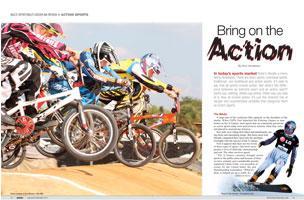
 |
| Photo courtesy of Dan Mooney/ABA BMX |
In today's sports market there's literally a menu being developed. There are team sports, individual sports, traditional, non-traditional and action sports. It's safe to say that all sports involve action. But what's the difference between an extreme sport and an action sport? Some say, nothing, others say plenty. Either way you look at it; they all involve action,it's just the inherent risk of danger and unpredictable variables that categorize them as Action Sports.
The Media
A large part of the confusion falls squarely on the shoulders of the media. When ESPN first launched the Extreme Games or now known as the X-Games, most sports that are commonly perceived as action sports today were perceived as extreme when they were introduced to mainstream America.
 |
| Photo © Neil Harrison - Dreamstime.com |
Sure kids were riding their bikes and skateboards, doing tricks and attempting jumps. But those same kids literally catapulted their sport into the spotlight overnight with the success of the X Games.
Now it appears that there are two levels of these types of sports. One level incorporates a level of difficulty, showmanship and risk. The other involves speed.
"The X Games certainly brought action sports to the public arena and because of them we have certainly seen considerable growth," explained Calum Clark, vice president of events for the United States Ski and Snowboarding Association. "What it's done is helped set up a really diverse set of action sports. Whether it's high speeds to really, really creative acrobatic sports. The differences of high styles and the athlete's creativity really aren't limited."
The USSA is the national governing body for Olympic skiing and snowboarding, and the parent organization for the U.S. Ski Team and U.S. Snowboarding.
 |
| Photo courtesy of Dan Mooney/ABA BMX |
The marketing of action sports has evolved as much as the sports themselves. Capturing the Gen Y audience is paramount to corporate America. Mountain Dew has been running the Dew Tour since 2005 and as a result increased their exposure to a younger generation. Nike 6.0 and Toyota have joined as title sponsors of the Dew Tour.
The corporate influence is also a factor in event planning. "That's certainly a consideration for us," explains Clark. "You go through the layers of all negotiations, of who your partners are and the rights holders. It's part of the business discussion."
USSA is a major part of an exciting event in an unexpected venue this month. They have partnered with Metro Denver Sports Commission and Sprinton the Denver Big Air event at Civic Center Park in Denver, Colo., January 25 and 26, 2011.
 |
| Photo courtesy of Dan Mooney/ABA BMX |
"We are really trying to bring the competition to the people," said Margo Christiansen of USSA."A lot of times our competitions are in big resorts and a little off the beaten path so we are bringing it right downtown in Denver. We are building a huge scaffolding system for the jumps. It's so progressive in the action sports industry."
Clark agrees. "It's an enormous undertaking by Denver Sports," he said. "The exciting thing is that we have an iconic venue in the Civic Center and a beautiful backdrop. It's going to be quite spectacular."
The LG FIS World Cup Snowboard Big Air has been held in Moscow, Barcelona, Quebec, Seoul and London, and is making its first stop in the United States.
According to the website, the ramp is a combination of the steel truss and scaffolding that will be 101 feet high, 300 feet long and 80 feet wide.
Biking and Boarding
The Olympics now include snowboarding and BMX which 10 years ago were considered extreme.
Both have experienced tremendous growth. There are over 270 ABA BMX tracks across the U.S. and Canada and over 60,000 members, double what there were in 1996.
 |
| Photo courtesy of Dan Mooney/ABA BMX |
The American Bicycle Association was formed in 1977, is the sanctioning body of BMX and holds 27 events annually.
John David, chief operating officer of ABA BMX, has been with the organization for 10 years and competing since he was seven years old. He has seen first hand the growth of the sport.
"It's pretty outstanding what we've experienced," said David. "The integration of BMX in the Olympics has helped the sport grow and that's been outstanding in the development of BMX tracks. There are 20 new BMX tracks built this year alone."
"We have a nine percent growth rate in BMX," explained David. "It's really phenomenal, especially in this economy."
Shayne Robinson is president of Peachtree City BMX in Georgia and also a competitor. She is ranked 6th in the nation in her age category has been involved with the sport for 10 years since her son became involved.
"I see the sport blossoming," she said. "There will always be football and baseball but I see BMX growing because it's an individual sport and affordable. The attitude of people towards action sports has changed dramatically, there's no fear factor involved. I think very quietly it's just going to grow and blossom."
Similarly, snowboarding has shown strong growth since its birth in 1965. The USSA has 400 clubs, 30,000 members and sanctions 4,100 events annually.
Estimates show that as recently as 2004, there were 6.6 million participants in snowboarding.
"The dynamic of the sport and the progression of snowboarding and free skiing side of the sport is tremendous," said Clark.
Versus is an outdoor television network, and ABA BMX hosts a 30 minute show every Wednesday exposing the sport to a multitude of potential riders every week.
 |
| Photo courtesy of Dan Mooney/ABA BMX |
Versus and NBC will also be broadcasting Denver's Big Air event live.
Coming to Town
Sports tournaments and events provide a beneficial revenue stream for destinations. Like all events, they have specific requirements.
The main consideration is pretty obvious for USSA, snow.
With up to 28 events planned on an annual basis for Clark's team, there are some event destinations that have been set for five years while others are planned the season before. Considerations, however, remain the same when choosing a destination.
"Planning is very similar to most events," said Clark. "Things like infrastructure and organizing committees. How they interlink with the community, as well as basic stuff, access to hotels and cost of services within the town.
"A lot of time we try to marry the goals of what we try to achieve from an organizational standpoint with the organizing committee so that it makes sense for both sides. You need to take a lot of care and come to a conclusion that it's good for all parties."
The same holds true in BMX. "The approach I always take is zoom out and zoom in," explained David. "I look at airport accessibility, hotel room inventory and proximity to the track. Then I zoom in. What does the community have to offer? What's unique about it?
"Then I start getting very specific to the facility for the BMX track," he continued. "Is there ample parking, enough seating for spectators, the physical quality of the BMX track and finally is it a strong club?"
Another requirement: Dirt.
"Destinations have gone out and outsourced the dirt," said David. "It has become multi-use for them. Then we bring in our crew and construct the BMX track, it takes four days to construct, three days to race and clean up on Monday.
"We do everything ourselves besides the basics," he continued. "Everything is driven by the ABA. Any Sports Commission or CVB will tell anyone that we are one of the easiest groups to work with because we roll our sleeves up and get it done."
Columbia, South Carolina, is one of the few destinations in the country that has two locations. Columbia ABA BMX track and Lexington NBL BMX track both host regional and national events.
Scott Powers, executive director of the Columbia Regional Sports Council, credits those facilities for the area's success with BMX events.
"They are really facility driven," said Powers. "If you want a national or regional you have to have a quality facility. You can't skimp on that. We made sure they did the research on it and built a great facility. That's probably the key in hosting one of those events.
"Once the competition starts," Powers continued. "They start planning so far in advance and have a good working relationship with the track. They do everything and it's all self-contained. They put on a great event and everybody has a great time."
Robinson agrees. "It's important that the facility itself is well maintained," she said. "Is the track safe and offer enough surrounding space for campsites? Good restroom facilities, hospitality and great deals on the hotels. Peachtree City hotels are within five minutes from any sports facility, that's a key asset in Peachtree City, that's what has sold our facility in particular. The facility is top notch."
Bring the Whole Family
Sports are traditionally family based events, but individual action sports actually take it up a notch.
"It's a real family atmosphere," said Powers. "The entire family always comes. Even the adults race. Some of them are fathers and mothers that race with kids. These events have the capacity to bring a larger impact per competitor than some other events."
For the Robinson family, the individuality of the sport rivaled anything else. "We came into in 2000," explains Robinson. "This sport caters to the individual. My son doesn't want the team to win for him. It's a sport that fit him and allowed him to be responsible for himself and his wins and losses.
"The beauty of this sport is that it's truly a sport for family," she continued. "We have kids that come back to compete. They started at 19 or 20 years old and come back at 30 and compete alongside their kids. There's always something for an entire family to do."
ABA BMX promotes both elements in supporting the sport. "I tell people that BMX's greatest attribute is that it's an individual sport, not a team sport," said David. "But it is in fact a team sport. The team is the family unit. Dad is the coach and mechanic, mom is the head of the cheering section. For me, our family unit was the team. That's invaluable. There are very few things in life you can do as a family like this."
Safety First
It's understandable that the perceived notion is that there is a higher risk of injury when watching BMX, skateboarding or snowboarding.
But with the technology and new product development that has taken place over the last decade, risk of injury is thankfully decreasing.
As a mother and a rider, Robinson is thankful for the changes. "The sports themselves make them a lot safer with better equipment," she said. "We've come a long way. The tracks are faster but much safer and the extreme title is dropping off. The jumps are bigger but safer because your equipment is safer, bikes used to weigh 25-27 pounds and now weigh 12-14 pounds. The helmets and body protection are lighter and more effective."
David agrees. "When we talk about the quality," he said. "Years ago it was jeans and a t-shirt and as they get involved, they will go out and buy riding gear and a nice helmet. They really protect the rider and the same holds true for the bikes. That has helped with the growth of the sport and it's a very affordable sport."
And provides plenty of action.

